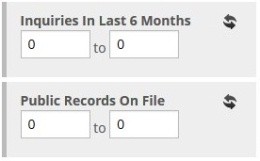Part 1 – An Overview
Part 2 – Lending Step-by-Step
Part 3 – Filtering Loans
Part 4 – Final Pieces
In part two we covered peer to peer lending’s basic five-step process. For part three we will focus on the most complicated step of that process: filtering. It is fairly easy to open an account at Lending Club or Prosper, and it is just as easy to invest in a diversified portfolio of 200 notes. The most difficult part for every lender is the process of selecting which notes to purchase out of the multitude of notes that are available on the platform.
Today, Lending Club has 2145 notes available, while Prosper has 266. Out of this crowd, some notes will perform better than others. Some will go late and default while others will be religiously paid back on time. So how can you tell which ones to invest in?
Statistics Are Amazing
This is a job for statistics. Both of the platforms have made available their loan history to the public in a spreadsheet (CSV file) that anybody can download. Lenders have set up third-party websites, like Michael over at NickelSteamroller.com, with easy-to-use statistical tools to help people run cross-sections of all the historical borrowers.
 This might be difficult to understand, so maybe it would help to use an example. Let’s look at the most recent presidential election. When Barack Obama squared off against Mitt Romney late last year, a lot of attention was given to the State of Ohio. This is because, since 1944, a president has rarely been elected without winning Ohio (the only exception being Kennedy’s win over Nixon in 1960). History gives us a picture for how things will happen in the future. Not a guarantee, but a solid clue as to how things may happen again.
This might be difficult to understand, so maybe it would help to use an example. Let’s look at the most recent presidential election. When Barack Obama squared off against Mitt Romney late last year, a lot of attention was given to the State of Ohio. This is because, since 1944, a president has rarely been elected without winning Ohio (the only exception being Kennedy’s win over Nixon in 1960). History gives us a picture for how things will happen in the future. Not a guarantee, but a solid clue as to how things may happen again.
The act of choosing worthy loans is very much like how Ohio usually picks the presidency. If we run some simple tests, we find that some borrowers are more historically likely to default than others. For instance, borrowers who have experienced a bankruptcy are more likely to not pay their loans back. The same goes for people who are using their loan to start a business.
History as Prophesy
This makes sense if we think about it. Borrowers who have had a past bankruptcy are more likely to be financially-undisciplined people. They are not guaranteed to be undisciplined, but it increases the chances that they are. Similarly, people who use their loan to start a business are often counting on this business to make them the money they will use to pay the loan back. But we all know that many new businesses fail within the first year or two, so it makes sense that these borrowers are statistically more likely (though not guaranteed) to default on their loans.
We excel at filtering peer to peer loans by finding a borrower description that is more likely than average to be responsible. This is not to say that you can do fine without these tools. Lending Club and Prosper do a good job at pre-filtering out many of the bad loans. But we can further refine our lending by choosing loans from borrowers who are more likely to be responsible. Those with longer employment, longer credit histories, more credit lines, higher incomes, and good credit scores are some of the borrowers most likely to pay back their loans.
Let’s create a Lending Club filter that shows us a group of borrowers who are statistically more responsible:
1. Go to a third-party tool
Click on this NickelSteamroller.com link to go to their Return Forecaster tool. The page that comes up lists 102,000+ loans that have been issued on the Lending Club platform. If you look further down you can see how the return on investment (ROI) for all these loans combined is 7.41%. Not bad! This is way better than the savings rate of your local bank, which is probably mired somewhere around 0.5%. We want to make this ROI go up! This is done by filtering these thousands of loans (Note: numbers are from 1/29/2013, and will have changed slightly if time has passed).
2. Insert Some Simple Filters
You will see a list of filters on the left hand side of the page. Scroll down until you see the following filters and change them to zero.

Inquiries in Last 6 Months = 0: I only invest in Lending Club loans with zero inquires on their credit report. Filtering a person’s inquiries is perhaps the best filter we can use to avoid risk. These inquiries are the number of times the borrower has applied for credit within the past six months. If a borrower has multiple inquiries, they are more likely to default, because they may have been rightly denied by somebody else and are shopping around for a loan.
Public Records on File = 0: If you scroll down near the bottom of the list, you will see this great filter. A public record shows up on a person’s credit report if they have had a bankruptcy, lien, or judgment against them. Avoid these borrowers: make this a zero as well.
Create Your Filter
Now scroll to the top (or bottom) and click on the button that says ‘Filter’. What happens when we trim down those thousands of historical Lending Club loans with these two simple filters? Our ROI goes up to 8.32%! Not bad for such little effort. As you can see, the 102,000 loans have also been trimmed in half, meaning that half the issued loans in Lending Club’s history are borrowers with a past inquiry or public record. This is a good reminder that some loans are better than others.
As you take time to learn to use these tools for yourself, you will begin to see the characteristics of default-prone borrowers. As a result, your filters will get better at avoiding defaults so as to receive a better return on your investment. For those of you who want to learn more about filtering peer to peer loans, you can enter your email in the box below. My free eBook has over fifteen pages devoted to filtering loans in order to achieve both lower defaults and higher returns.
In the final part of this series, we will be examining how we maintain our peer to peer lending accounts over time.
[image credit: flikr “flikr1077” CC-BY 2.0]



Fascinating! I am eager to try this out for myself :)
Welcome Alissa.
Thanks for the great info Simon. I am very interested in trying out this P2P lending:) I look forward to receiving your eBook and learning more.
You’re very welcome Janet. Hope it is of use to you.
Would love to get the ebook!